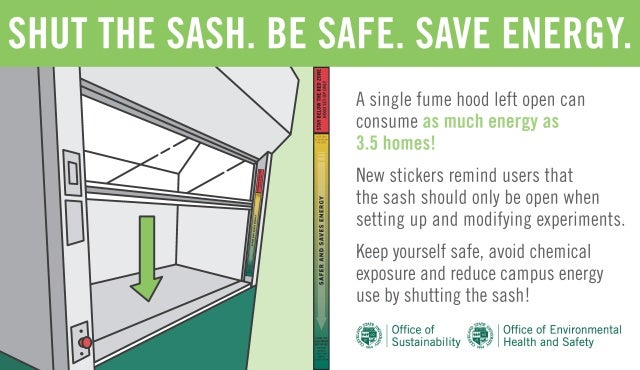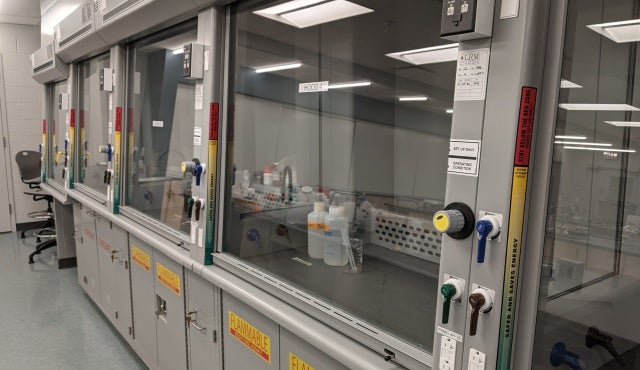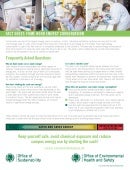Sustainability
Contact Information
Joe Minerd
Utilities and Sustainability Mgr.
Cleveland State University
1802 E 25th Street, PS 213
Cleveland, OH 44114
216-407-8305
https://www.csuohio.edu/sustainabilityShut the Sash
FUME HOOD ENERGY CONSERVATION
Fume hoods are one of the largest energy users on campus. In fact, laboratory ventilation systems can account for half of all energy used in a lab and a single fume hood can consume as much energy as 3.5 homes! Their high energy consumption is due to the fact that air is constantly exhausted to the outdoors. The best way to reduce energy consumption from fume hoods is to close the sash when the hood is not in use. The sash is also a safety barrier, so the fume hood sash should only be opened to set up or modify an experiment.


Frequently Asked Questions:
What is a fume hood?
A fume hood is a piece of equipment enclosing a work space in a laboratory. It provides ventilation that limits exposure to hazardous fumes released during experimental procedures.
Why do fume hoods use so much energy?
Labs require more air exchanges than other spaces on campus. Heating and cooling require significant amounts of energy and in a lab, all that cool or warm air is exhausted straight to the outdoors through the fume hood and cannot be recirculated. Conditioning the air and running large fans for ventilation consumes a lot of energy.
How does shutting the sash save energy?
Many fume hoods at CSU are variable air volume (VAV), meaning that a motor varies the air flow depending on the sash height. The motor and fans work harder when the sash is wide open and HVAC systems also have to work harder to condition the air. The fan speed and volume of air being moved decreases when the sash is lowered, all of which results in significant energy savings.
Is it safe to shut the sash?
The sash is an important safety barrier between the fume hood interior and the laboratory. The fume hood sash should only be open when setting up an experiment or when directly manipulating substances within the hood, and then only to the lowest level necessary to perform the experiment. Always close it fully when not in use. Even when shut, there is still some air flow through the hood to remove any fumes.
What information is on the new “Shut the Sash” stickers?
The stickers are a prompt to remind laboratory users to shut the sash when they are not actively working at the hood. They identify four key aspects for users:
- Maximum operating height of the fume hood sash
- The lower the sash position, the more energy saved
- Lowering the sash during operation promotes safety
- Sash should be shut completely when not in use
Will these stickers actually save energy?
Actual results will depend on lab users, but U.S. Department of Energy research showed the stickers resulted in dramatic increases in lab safety and energy efficiency.
What other lab practices can reduce energy consumption?
- Only use the button labeled Ventilation Start in an emergency. It increases air exchange to maximum capacity and is extremely energy intensive. Pull the button out to deactivate.
- Never store chemicals in a fume hood. Use a safety cabinet which doesn’t require large volumes of air flow.
- Use the right size equipment for the task and turn it off when not in use, especially equipment that must maintain a set temperature, whether hot or cold.

Download the FACT SHEET: Fume Hood Energy Conservation (pdf 274 KB).

Learn more:
Keep yourself safe, avoid chemical exposure, and reduce campus energy use by shutting the sash!
Contact Information
Joe Minerd
Utilities and Sustainability Mgr.
Cleveland State University
1802 E 25th Street, PS 213
Cleveland, OH 44114
216-407-8305
https://www.csuohio.edu/sustainability